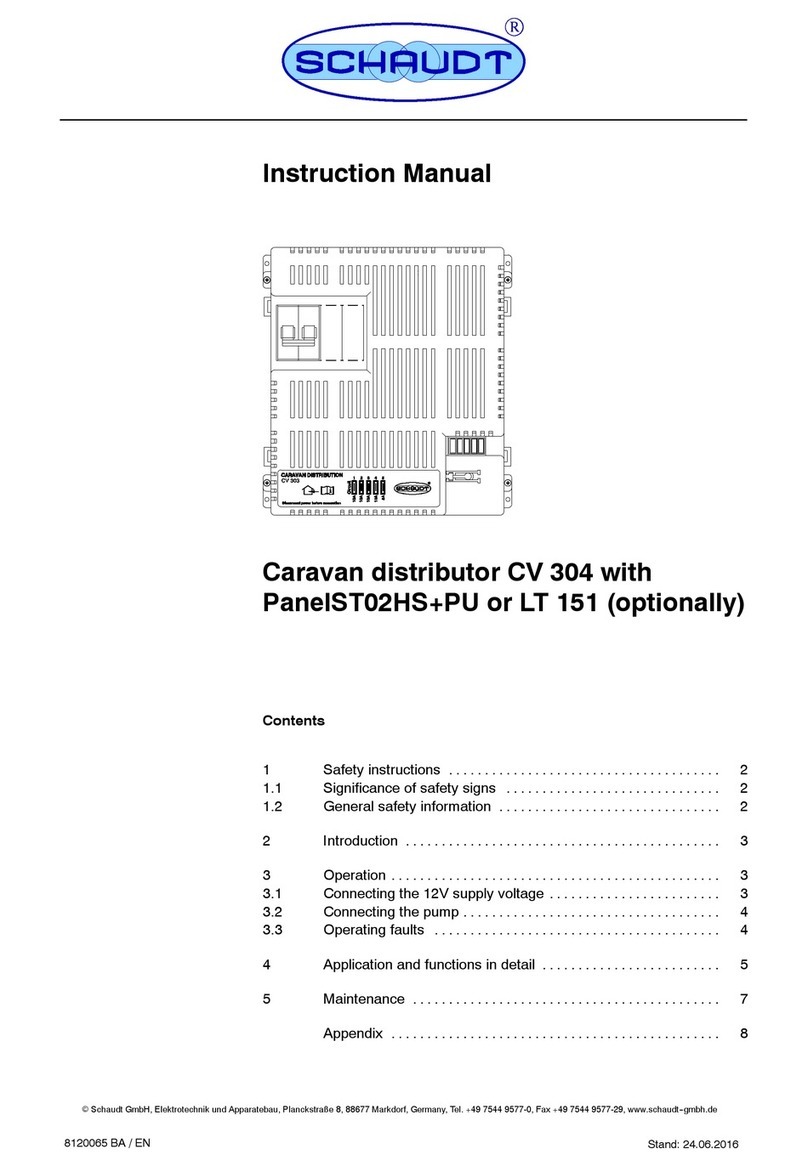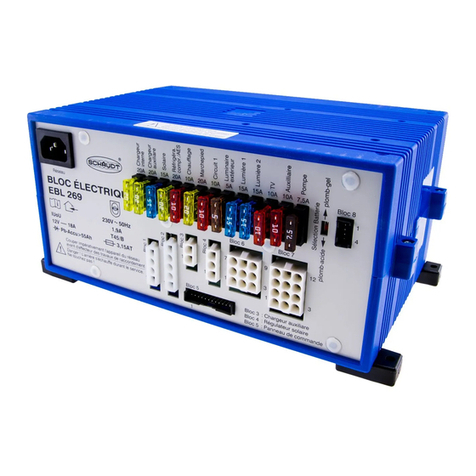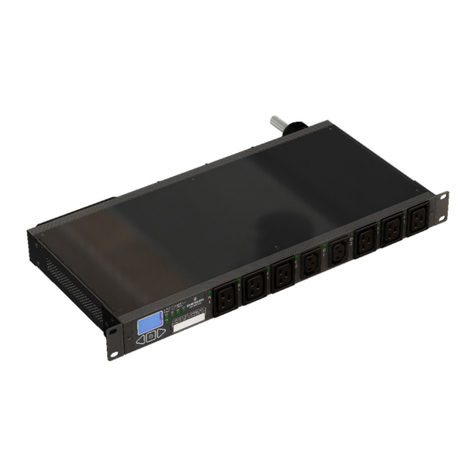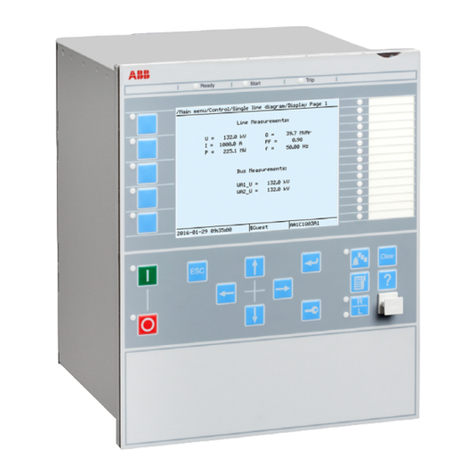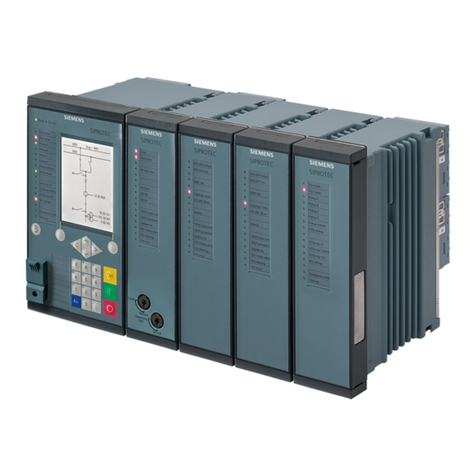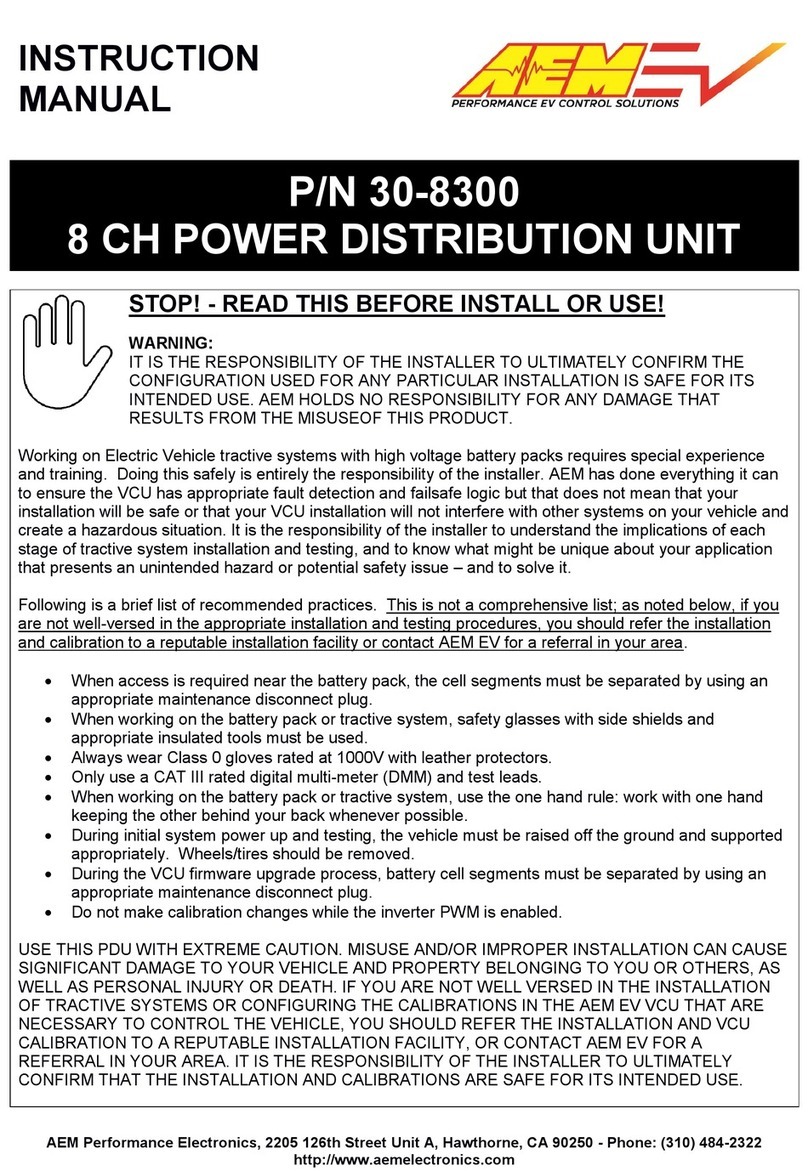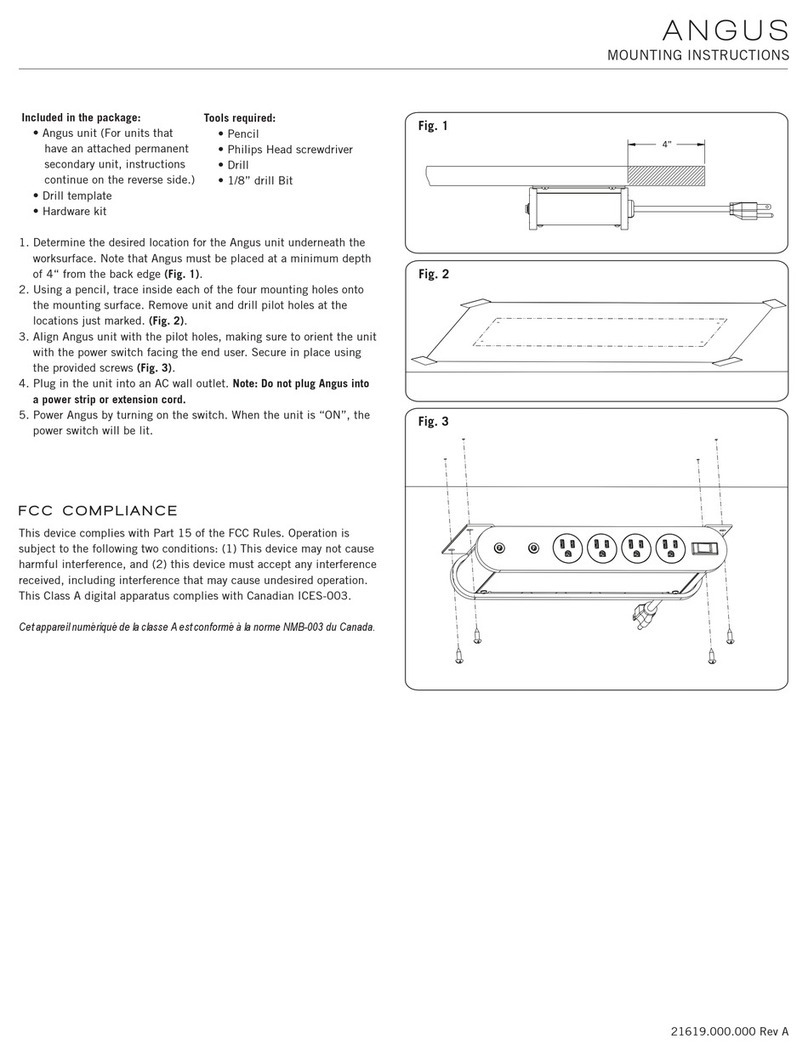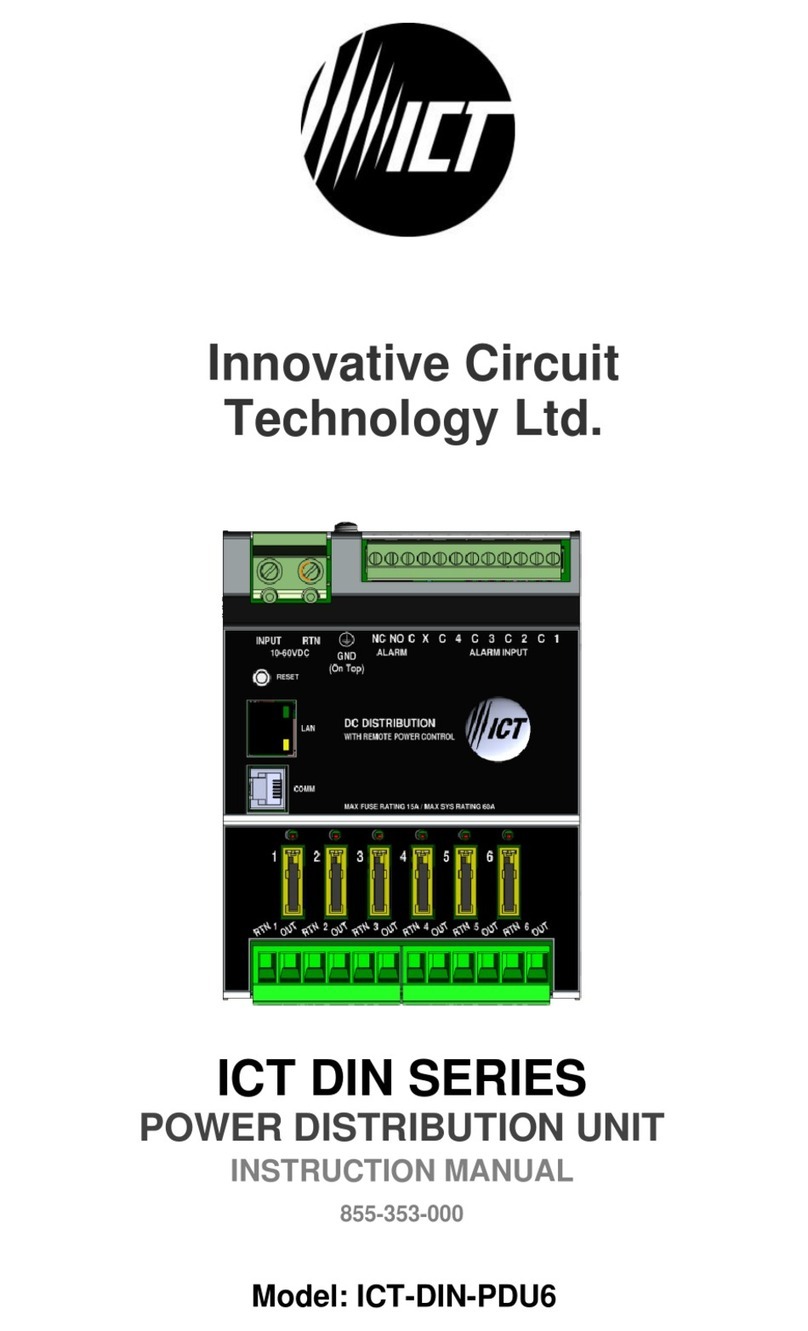Schaudt CSV 409 User manual

Issued: 20.02.2020
ESchaudt GmbH, Elektrotechnik und Apparatebau, Planckstraße 8, 88677 Markdorf, Germany, tel. -0, fax +49 7544 9577-29, www.schaudt--gmbh.de
8050101 BA / EN
Instruction manual
CSV 409 A caravan charging system
Table of contents
1 Introduction 2............................................
2 Safety information 2......................................
2.1 Significance of the warning signs 2..........................
2.2 General safety instructions 2...............................
3 Application and function 3.................................
3.1 Battery functions 5........................................
3.2 Additional functions 5.....................................
4Design 6................................................
5 Operation 7..............................................
5.1 Switching on and off 7.....................................
5.2 Starting the system 8.....................................
5.3 Changing the battery 9....................................
5.4 Operating faults 10........................................
5.5 Shutting down the system 10................................
5.6 Closing down the system 11................................
6 Technical details 11........................................
6.1 Mechanical details 11......................................
6.2 Electrical details 11........................................
6.3 Environmental parameters 13...............................
7 Maintenance 13...........................................
Appendix 14..............................................

CSV 409 A caravan charging system instruction manual
2Issued: 20.02.2020 8050101 BA / EN
1 Introduction
This instruction manual contains important information for the safe operation
of equipment supplied by Schaudt. It is imperative that you read and follow
this safety information.
The instruction manual should always be kept in the vehicle. All safety infor-
mation must be passed on to other users.
2 Safety information
2.1 Significance of the warning signs
YDANGER!
Failure to comply with this sign may result in danger to life and limb.
YWARNING!
Failure to comply with this sign may result in somebody being injured.
YATTENTION!
Failure to comply with this sign may damage the device or the connected
consumers.
YThis sign indicates recommendations or special features.
2.2 General safety instructions
The design of the device is state-of-the-art and complies with the approved
safety technology. Nevertheless, somebody might be injured or the device
might be damaged if you do not abide by the safety information given in this
instruction manual.
Do not use the device if it is not in a perfect technical condition.
Any technical faults affecting the personal safety or the device must be dealt
with immediately by qualified personnel.
YDANGER!
230 V unit carrying mains voltage.
Risk of fatal injury due to electric shock or fire:
FThe motorhome or caravan’s electrical system must comply with DIN,
VDE and ISO regulations.
FNever try to modify the electrical system.
FNever try to modify the device.
FOnly qualified electricians are permitted to make the electrical con-
nections in accordance with the installation instructions supplied by
Schaudt.
FThe connection work must only be undertaken after the power has
been disconnected.
FNever try to start the device using a defective mains cable or a faulty
connection.
FNever undertake maintenance on the device when it is live.

CSV 409 A caravan charging system instruction manual
3
Issued: 20.02.2020
8050101 BA / EN
YDANGER!
Incorrect installation!
Electrical shock or damage to the connected device:
FThe device must be installed in accordance with the installation
instructions.
FThe mains connection line may only be replaced by an authorised cu-
stomer service department or by qualified persons.
YWARNING!
Hot components!
Burns:
FBlown fuses may only be changed after the power to the system has
been disconnected.
FBlown fuses may only be replaced when the cause of the fault is
known and eliminated.
FNever bypass or repair fuses.
FThe back of the device can get hot during operation. Do not touch.
FOnly use original fuses rated as specified on the device.
FNever store heat sensitive objects close to the device (e.g.
temperature sensitive clothes if the device has been installed in a
wardrobe).
3 Application and function
YThis device is not intended to be used by persons (including children)
with limited physical, sensory or mental aptitude or lack of experience
and/or knowledge unless they are supervised by a person responsible for
their safety or have received instruction from this person as to how the
device is used.
Children are to be supervised so as to ensure they do not play with the
device.
This device is intended for installation in a vehicle.
CSV 409 A
+--
+--
Caravan charging system
230 V AC
12 V consumer Caravan battery
Starter battery
Lighting
Pump
Heater
etc.
LR ...
Solar control
(accessory)
Towing vehicle
ST ... switch panel
Fig. 1 Onboard power supply system

CSV 409 A caravan charging system instruction manual
4Issued: 20.02.2020 8050101 BA / EN
The CSV 409 A caravan charging system is the central power supply unit for
all 12 V consumers connected to the caravan’s electrical system. It is nor-
mally fitted inside a cabinet or a stowage space and can be accessed from
the front to change a fuse.
The caravan charging system has been designed solely for connecting up to
a 12 V onboard supply.
Connected units can be supplied from the caravan battery or the towing
vehicle’s battery if a mains supply is not available.
Since the device provides a hum-free, stabilised output voltage, it is also
possible to connect and supply power to sensitive consumers (e.g. transistor
lamps or radios).
The CSV 409 A caravan charging system consists of:
FA charging module for recharging all of the connected batteries
FThe complete 12 V distribution system
FThe fuses for the 12 V power circuits
FA battery booster
At least one switch panel ST ... has to be connected for operation.
Connection options are available for:
FSolar charger
F12 V indicator
FMains indicator
F12 V supply to a control and display panel
Flat vehicle fuses are used to protect the various circuits.
FOvertemperature
FOverload
FShort circuit
230 V AC voltage 10 %, 47 -- 63 Hz sinewave, protection class I
12 V outputs shall only be loaded up to a maximum of 90 % of the rated
current of the associated fuse (see block diagram or nameplate).
All of the consumers must not exceed the following loads when combined:
FMains operation: 28 A
FOperation with towing vehicle and ignition ON: 8 A
Modules
Required
control circuits
Protective circuits
Mains connection
Current-carrying
capacity
Maximum total current

CSV 409 A caravan charging system instruction manual
5
Issued: 20.02.2020
8050101 BA / EN
3.1 Battery functions
6-cell lead-acid or lead-gel batteries from 80 Ah upwards
Charging the caravan battery whilst driving; increasing the supply voltage
coming from the towing vehicle via the battery booster
The 12V main switch (rocker switch with neutral position on the control and
switch panel) disconnects all 12V consumers from the caravan battery
(except: the control electronics of a refrigerator).
This prevents the caravan battery from being slowly discharged by closed-
circuit current.
The batteries can still be charged using the caravan charging system, the
towing vehicle or the solar charger, even when the main battery-switch is
switched off.
The switching option provided by the battery selector switch ensures opti-
mum charging of the two different types of battery, lead-acid and lead-gel.
The consumers are switched off (except for the refrigerator) when the
caravan is hitched to the towing vehicle and the ignition is switched on
(power at terminal 10 and trailer hitch TH). The consumers can be switched
back on at any time. (The automatic disconnector does not prevent swit-
ching back on).
No closed circuit current when the ignition of the towing vehicle is switched
off; additional current consumption by the fridge’s control electronics (see
documentation supplied by the fridge manufacturer);
measured when all of the consumers inside the caravan are switched off
Caravan battery
Charging curve IUoU
Final charging voltage 14.4 V*
Charging current 28 A
Trickle charge voltage 13.7 V* with automatic switching
*Until 03/2020:
Final charging voltage 14,3 V; trickle charge voltage 13,8 V
Maximum charging current 8 A
3.2 Additional functions
This output supplies the control electronics in a fridge:
FFrom the caravan battery
FFrom the towing vehicle’s battery when the ignition is switched on
FFrom the mains supply when it is connected up
Y12V operation of the refrigerator only works if the caravan is connected to
a towing vehicle with the engine running.
Suitable batteries
Battery charging
whilst driving
12 V main switch
Battery selector switch
Automatic disconnector
Closed-circuit current
coming from towing
vehicle battery
Battery charging from
mains connection
Battery charging from
towing vehicle operation
Fridge controller

CSV 409 A caravan charging system instruction manual
6Issued: 20.02.2020 8050101 BA / EN
YATTENTION!
Total discharge!
Damages the caravan battery/towing vehicle battery:
FAvoid continuous 12 V operation. The refrigerator only operates on
12 V when the caravan is hitched to the towing vehicle and the ignition
is switched on.
Maximum permitted charging current 14 A, protected by a 15 A fuse
4 Design
1
1312
1110
2
3
4
5 6 8 9 14 15 16 17 18 19 20 21 22
24
25
26
237
Fig. 2 CSV 409 A caravan charging system viewed from front
1 Circuit 5 connections 14 Flat vehicle fuse for fridge controller
2 Circuit 3 connections 15 Circuit 2 connections
3 Pump connections 16 Circuit 1 connections
4 Adhesive label 17 Fridge controller connection
5 Fixing lug with drilled hole 18 LRS ... solar charger connection
6 Switch 1 and 2 pump connections 19 Indicator and control connections
7 Adhesive label 20 Solar flat fuse
8 Circuit 5 flat vehicle fuse 21 Selector switch for selecting lead-gel/lead-acid battery
9 Circuit 3 flat vehicle fuse 22 Caravan battery connection
10 Flat vehicle fuse for pump 23 Mains cable
11 Flat vehicle fuse for charger module 24 Trailer hitch plug-in connection
12 Circuit 1 flat vehicle fuse 25 Refrigerator supply connection
13 Circuit 2 flat vehicle fuse 26 Housing
Battery charging via
solar charger

CSV 409 A caravan charging system instruction manual
7
Issued: 20.02.2020
8050101 BA / EN
5 Operation
Operation of the caravan power supply occurs exclusively via the connected
control and switch panel.
The CSV 409 A caravan charging system does not require daily operation.
Settings only have to be carried out once if the battery type is changed
(lead-acid or lead-gel), during initial start-up or when retrofitting accessories
(see chapter 5.3 and the CSV 409 A installation instructions).
5.1 Switching on and off
5.1.1 Control and switch panels of type LT ...
The control and switch panels of type LT ... are supplied with individual ope-
rating instructions included with the vehicle. Please refer to these instruc-
tions for operating information.
5.1.2 Switch panel ST 05
Fig. 3 Switch panel ST 05
In the simplest case, the switch panel ST 05 is connected to the caravan
power supply. It simply has a rocker switch with neutral position.
The 12 V supply to the living area is switched on via the switch. Exception:
FCompressor/AES refrigerator control
YWhen starting these consumers for the first time after switching off the
CSV 409 A caravan power supply, replacing the battery or reconnecting
the leisure battery after a longer period, the 12 V main switch on the
switch panel must be switched on briefly.
Press the left-hand button briefly.
The 12 V power supply to the living area is switched on.
Press the right-hand button briefly.
The 12 V power supply to the living area is switched off.

CSV 409 A caravan charging system instruction manual
8Issued: 20.02.2020 8050101 BA / EN
5.2 Starting the system
YATTENTION!
Caravan charging system can be set up incorrectly!
The connected devices will be damaged. Therefore prior to starting:
FYou must ensure that the battery selector switch (Fig. 2, Pos. 21) is
set to the correct position for the type of battery being used.
Press the rocker switch so that it is briefly in the “ON” position.
The 12 V main switch switches all consumers on and off (exception: a
fridge’s control electronics).
YATTENTION!
Violation of 230 V mains voltage limit!
Will damage the caravan charging system, 12 V consumers or other con-
nected devices:
FThe generator must not be switched in until it is running smoothly.
FIt is essential that the generator complies with the mains supply speci-
fications.
FDo not connect the caravan charging system to the onboard mains
voltage on car ferries (a non-problematic mains voltage cannot always
be guaranteed on car ferries).
Utilisation of an upstream overvoltage protection device (OVP) is
recommended.
YATTENTION!
Battery buffer function missing!
The connected devices will be damaged:
FNever run the solar charger without a battery being connected.
YATTENTION!
Battery discharge!
Towing vehicle cannot be started:
FSwitch off the ignition when the towing vehicle is at a standstill.
12 V main switch
Generator operation and
car ferries
Solar charger operation
Towing vehicle
operation

CSV 409 A caravan charging system instruction manual
9
Issued: 20.02.2020
8050101 BA / EN
5.3 Changing the battery
YATTENTION!
Wrong battery type or incorrectly connected battery!
Will damage the battery or the devices connected up to the caravan
charging system:
FBatteries shall only be changed by qualified personnel.
FFollow the instructions of the battery manufacturer.
FThe caravan charging system is to be used solely for connecting the
12 V power supply to 6-cell lead-gel or lead-acid batteries. Never use
unapproved types of battery (e.g. NiMH batteries).
YOnly batteries of the same type and capacity should normally be used,
i.e. same as those installed by the manufacturer.
YYou can change over from lead-acid to lead-gel batteries. You cannot
change over from lead-gel to lead-acid batteries! Your vehicle manufactu-
rer will provide you with information about this.
Disconnect the battery from the caravan charging system by switching
the 12 V main switch off.
Unhitch the caravan from the towing vehicle.
Replace the battery.
Check once more to ensure that you have fitted the correct type of bat-
tery afterwards.
YDANGER!
Battery selector switch set incorrectly!
Danger of explosion caused by the build up of oxyhydrogen gas.
FSet the battery selector switch to the correct position.
YATTENTION!
Battery selector switch set incorrectly!
The battery will be damaged.
FSet the battery selector switch to the correct position.
Disconnect the caravan charging system from the mains before resetting
the battery selector switch.
Move the battery selector switch (Fig. 2, Pos. 21) into the relevant posi-
tion using a thin object (e. g. ball-point pen):
FLead-gel battery: Set the battery selector switch to “Lead-gel” (Gel).
FLead-acid battery: Set the battery selector switch to “Lead-acid”
(Säure).
Start the system as instructed in Chapter 5.2.
Changing the battery
Starting up
the system

CSV 409 A caravan charging system instruction manual
10 Issued: 20.02.2020 8050101 BA / EN
5.4 Operating faults
The majority of power supply system faults are caused by blown fuses.
Please contact our customer service address if you cannot eliminate the
fault using the following table.
If this is not possible, e.g. if you are abroad, you can have the caravan char-
ging system repaired at a specialist workshop. In this case you must ensure
that the warranty is not invalidated by incorrect repairs being carried out and
Schaudt GmbH will not accept any liability for damage resulting from such
repairs.
Fault Possible causes Remedy
Caravan batter
y
is not No mains volta
g
eSwitch the cut-out in the
C
a
r
a
v
a
n
b
a
t
t
e
r
y
i
s
n
o
t
charged during 230 V
N
o
m
a
i
n
s
v
o
l
t
a
g
e
S
w
i
t
c
h
t
h
e
c
u
t
o
u
t
i
n
t
h
e
vehicle back on; check the
g
g
operation
;
mains voltage
Defective caravan
charging system
Call customer service
Caravan battery is not
charged whilst driving
Defective alternator Have the alternator
checked
g
g
No voltage supplied to
“Ignition ON” input or per-
t
l
Have the fuse and wiring
checked
g
p
p
manent plus Check the towing vehicle
plug connection
Defective caravan
charging system
Call customer service
Solar charger is not wor- Solar charger not plugged Plug the solar charger in
S
o
l
a
r
c
h
a
r
g
e
r
i
s
n
o
t
w
o
r
king (mains supply off)
S
o
l
a
r
c
h
a
r
g
e
r
n
o
t
p
l
u
g
g
e
d
in
P
l
u
g
t
h
e
s
o
l
a
r
c
h
a
r
g
e
r
i
n
Defective fuse or wiring Have the fuse and wiring
D
e
f
e
c
t
i
v
e
f
u
s
e
o
r
w
i
r
i
n
g
H
a
v
e
t
h
e
f
u
s
e
a
n
d
w
i
r
i
n
g
checked
Defective solar charger Have the solar charger
checked
1
2
V
p
o
w
e
r
s
u
p
p
l
y
i
n
t
h
e
1
2
V
m
a
i
n
s
w
i
t
c
h
i
s
1
2
V
m
a
i
n
s
w
i
t
c
h
m
u
s
t
b
e
1
2
V
power supp
l
y
i
n
t
h
e
l
i
v
i
n
g
a
r
e
a
d
o
e
s
n
o
t
w
o
r
k
1
2
V
ma
i
nsw
i
t
c
h
i
s
s
w
i
t
c
h
e
d
o
f
f
1
2
V
ma
i
nsw
i
t
c
h
mus
t
b
e
s
w
i
t
c
h
e
d
o
n
living area does not work switched o
f
f
switched on
g
Defective fuse or wiring Have the fuse and wiring
D
e
f
e
c
t
i
v
e
f
u
s
e
o
r
w
i
r
i
n
g
H
a
v
e
t
h
e
f
u
s
e
a
n
d
w
i
r
i
n
g
checked
Defective caravan
charging system
Call customer service
Caravan charging system Defective caravan Call customer service
C
a
r
a
v
a
n
c
h
a
r
g
i
n
g
s
y
s
t
e
m
cannot be switched on
i
t
h
k
i
t
h
D
e
f
e
c
t
i
v
e
c
a
r
a
v
a
n
charging system
C
a
l
l
c
u
s
t
o
m
e
r
s
e
r
v
i
c
e
using the rocker switch No voltage supply Check the battery or
N
o
v
o
l
t
a
g
e
s
u
p
p
l
y
C
h
e
c
k
t
h
e
b
a
t
t
e
r
y
o
r
mains connection
Defective rocker switch Call customer service
YIf the device becomes too hot due to excessive ambient temperature or
lack of ventilation, the charging current is automatically reduced. How-
ever, always prevent the device from overheating.
5.5 Shutting down the system
Press the rocker switch (12 V main switch) so that it is briefly in the
“OFF” position.
Flat vehicle fuses

CSV 409 A caravan charging system instruction manual
11
Issued: 20.02.2020
8050101 BA / EN
5.6 Closing down the system
YATTENTION!
Total discharge!
Damages the caravan battery:
FThe caravan battery must be fully charged before closing down and
before restarting the system. (Vehicle with an 80 Ah battery must be
connected to the mains supply for at least 24 hours and a 160 Ah
battery for up to 36 hours.)
YATTENTION!
Permitted input voltage exceeded!
Will damage the consumers connected to the system:
FNever run a solar charger supplied by ’Schaudt’ without a battery
being connected to the system.
FUnplug the “+ solar-cell” connector on the solar charger first if the bat-
tery is going to be changed or removed.
Press the rocker switch (12 V main switch) so that it is briefly in the
“OFF” position.
The caravan battery must be fully charged before closing the system
down.
The caravan battery is then protected against total discharge. This applies
only if the battery is intact. Follow the instructions of the battery manufactu-
rer.
The caravan battery must be fully charged before closing the system
down.
Remove the clamps from the battery terminals.
Remove the “+ solar-cell” connector on the solar charger.
6 Technical details
6.1 Mechanical details
111 x 320 x 217 (H x W x D in mm), including attachment feet
2kg
PA (polyamide), gentian blue (RAL 5010)
6.2 Electrical details
230V AC 10%, 47 -- 63 Hz sinusoidal, protection class I
3.2 A
6-cell lead acid or lead gel batteries, 80 Ah and above
Without control and switch panel: 0 mA, plus consumption of refrigerator
control electronics;
With control and switch panel (e.g. LT310/LT409): approx. 2 -- 3 mA, plus
consumption of controller electronics of refrigerator
Closing down for up to
6 months
Closing down for more
than 6 months
Dimensions
Weight
Casing
Mains connection
Current consumption
Suitable batteries
Standby current from
Caravan battery

CSV 409 A caravan charging system instruction manual
12 Issued: 20.02.2020 8050101 BA / EN
Conditions for the measurement:
FApprox. 10 minutes after mains isolation without mains connection
F12.6V battery voltage
FBattery alarm OFF
FAll consumers switched off
F12V main switch off
12V outputs A maximum of 90% of the nominal cur-
rent
of the relevant fuse may be
drawn.
Caravan battery
Charging curve IUoU
Final charging voltage 14.4 V
Charge current 28 A in the entire mains voltage range,
electronically limited, minus the
charge current into the towing vehicle bat-
tery
Voltage for float charge 13.7 V with automatic switchover
New charge cycle, with battery voltage below 13.7 V
Switchover to main charging with approx. 5 seconds delay
Main charge
I
Full charge
Uo
Trickle charge
U
4 h for lead--acid
16 h for lead--gel
Time
14,4
13.7
Ucharge
V
Fig. 4 Example of the charge voltage behaviour with the CSV 409 A caravan charging sy-
stem
I Main charge with maximum 28 A charging current, electronically limi-
ted, up to final charging voltage. The battery is now charged up to ap-
prox. 80%. Start of charge also for completely discharged batteries.
Uo Automatic changeover to full charge with constant 14.4 V. The duration
of the full charge phase depends on the type of battery and is configu-
red on the device: Lead-acid batteries, 4 hour, lead-gel batteries, 16
hours.
U Automatic changeover to compensation charge with constant 13.7V. In
the compensation charge phase, the voltage at the output of the char-
ging module is constant. The battery is now charged up to approx.
95%.
Start of a new charging cycle by switching over to main charge, if the battery
voltage falls below 13.7V for more than 5 seconds when loaded. Start of
charge also for completely discharged batteries. The internal charger mo-
dule can also be operated without the caravan battery.
Current--carrying
capacity
Battery charging via
mains connector

CSV 409 A caravan charging system instruction manual
13
Issued: 20.02.2020
8050101 BA / EN
Max. permitted charging current 14 A, protected by 15 A fuse
Simultaneous charging of caravan battery by alternator
Maximum charge current
to caravan battery 8 A, electronically restricted
6.3 Environmental parameters
-10 Cto+40C
-20 Cto+70C
Operation in dry environment only
CE mark?
7Maintenance
The CSV 409 A caravan charging system requires no maintenance.
Clean the caravan charging system using a soft, slightly damp cloth and mild
detergent. Never use spirit, thinners or similar substances. Do not allow fluid
to ingress the caravan charging system.
The reproduction, translation and duplication of this manual, even in parts, is
not allowed without written authorisation.
Battery charging via
solar charge regulator
Battery charging
whilst moving
Operating temperature
Storage temperature
Humidity
Yes
Cleaning
E

CSV 409 A caravan charging system instruction manual
14 Issued: 20.02.2020 8050101 BA / EN
Appendix
A CE Conformity Declaration
Schaudt GmbH hereby confirms that the design of the device complies with
the relevant regulations.
The original EU conformity declaration is available and can be referred to at
any time.
Schaudt GmbH, Elektrotechnik & Apparatebau
Planckstraße 8
88677 Markdorf
Germany
B Special fittings/Accessories
Schaudt solar charger LR ... model for solar modules with a total current of
14 A, including 0.5 m connection cable and connector plug
C Customer service
Schaudt GmbH, Elektrotechnik & Apparatebau
Planckstraße 8
88677 Markdorf, Germany
Phone: +49 7544 9577-16
Email: kundendienst@schaudt-gmbh.de
web: www.schaudt.gmbh
Returning a defective device:
Always use well-padded packaging.
Fill out and enclose the fault report; see Appendix D.
Send it to the addressee delivered free.
Manufacturer
Address
Solar charger
Customer service
address
Sending in the device

CSV 409 A caravan charging system instruction manual
15
Issued: 20.02.2020
8050101 BA / EN
D Fault report
In the event of damage, please return the defective device together with the
completed fault report.
Device type: _______________________
Article no.: _______________________
Vehicle: Manufacturer: _______________________
Model: _______________________
Own installation? Yes -No -
Upgrade? Yes -No -
Is the over-voltage protection (OVP) Yes -No -
(OVP) connected upstream?
There is the following defect:
(please tick)
Other remarks:
No
battery
charging
whilst
driving
No
battery
charging
from mains
Voltage Current
Permanent
fault
Temporary
fault/loose
contact
The
following
electrical
consumers
do not work:
Cannot
switch ON
or OFF

CSV 409 A caravan charging system instruction manual
16 Issued: 20.02.2020 8050101 BA / EN
E Block circuit diagram/Connection diagram
* Connections 9 and 10 must be
fused externally in the vehicle
up to a maximum of 15 A.
...
910 * Trailer hitch towing vehicle/
caravan connecting plug
assignment as per EN
1648-1
--
+Pump
230V~50Hz
TV
+
--
--
+Awning light
+
--
--
+
--
+
+
--
+
-- Fr cartridge; fuse fitted in vehicle
-- T H
+TH TH +12V perm. plus *9
13 negative to 9
11
10
-- T H
+TH
--
+
--
+
+
--
Fr controller, 2A
Switch Mode
S 1218
--
+
CSV 409
14.3V/28A
A12
A11
A3
A1
A2
Plug connector LF--PA 401
6.3 x 0.8 (32 way)
+
--
Plug cable
L = 1.2m
3G1.5
+
-- 12V
1
2
3
4
5
66
5
4
3
2
112V off
12V on
12V check
Mains indicator
MSFQ/0 6F pin strip
Circuit 5
Circuit 3
Circuit 2
Circuit 1
6.3 x 0.8
lead-acid
lead-gel/
Selector switch
negative to
TH +12V switched *
10
+Ua booster
14.25V
Caravan battery
+
2
1
3
2
1
3
Negative
+
3F MNL socket
Solar module
charger
Solar
LRS 1214
Booster
Molex minifit SR--2F BL2
11
--22
max. 40A
Pump switch 1
Pump switch 2
--
+Spare
Disconn.
automatic
7.5A
15A
15A
15A
5A
15A
2A30A
brown
white
green
ST 05 **
** optionally, in place of LT ...
Table of contents
Other Schaudt Power Distribution Unit manuals
Popular Power Distribution Unit manuals by other brands
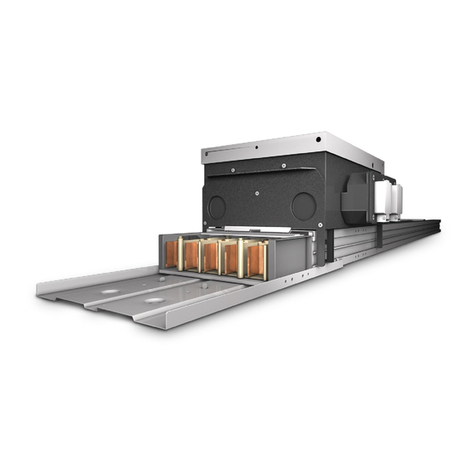
Siemens
Siemens SIVACON 8PS BD2 Series installation instructions

CHIEF
CHIEF PAC525P2-KIT installation instructions

Omicron
Omicron CMC 850 user manual
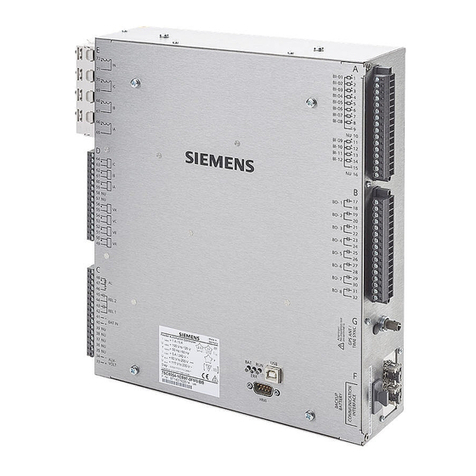
Siemens
Siemens SIPROTEC 7SC805 manual
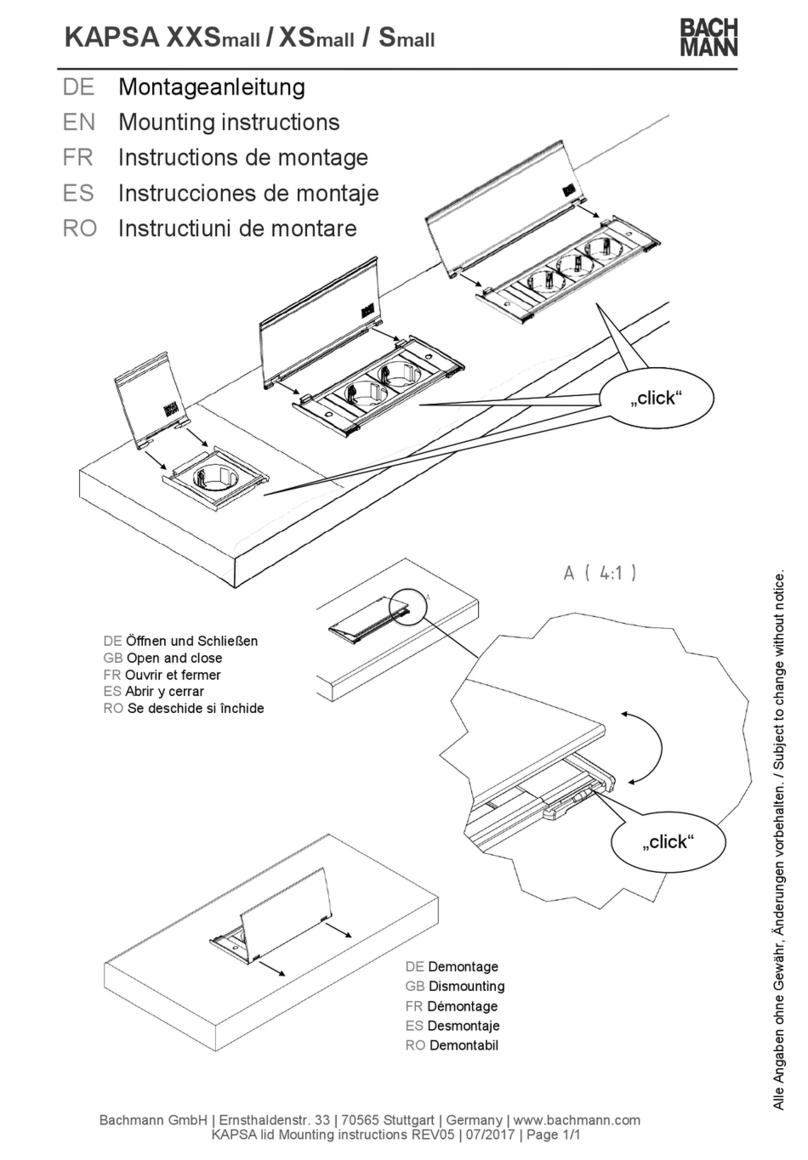
Bachmann
Bachmann KAPSA XXS Mounting instructions
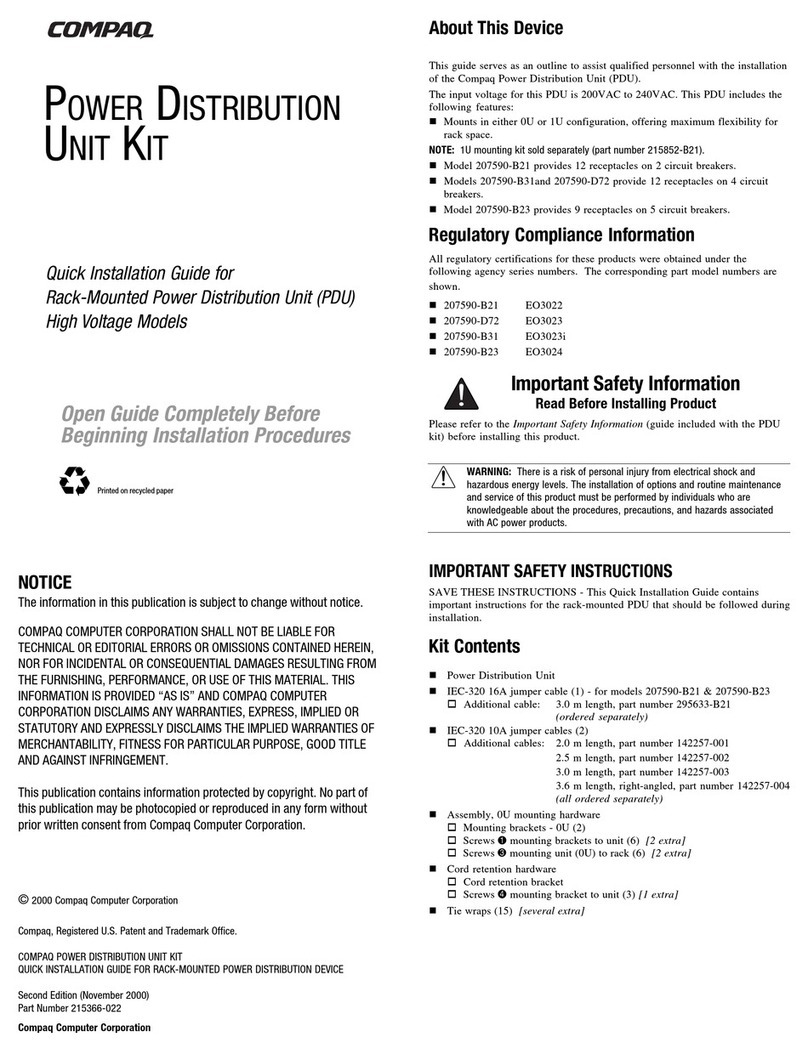
Compaq
Compaq 207590-B21 - Power Distribution Unit Strip Quick install guide
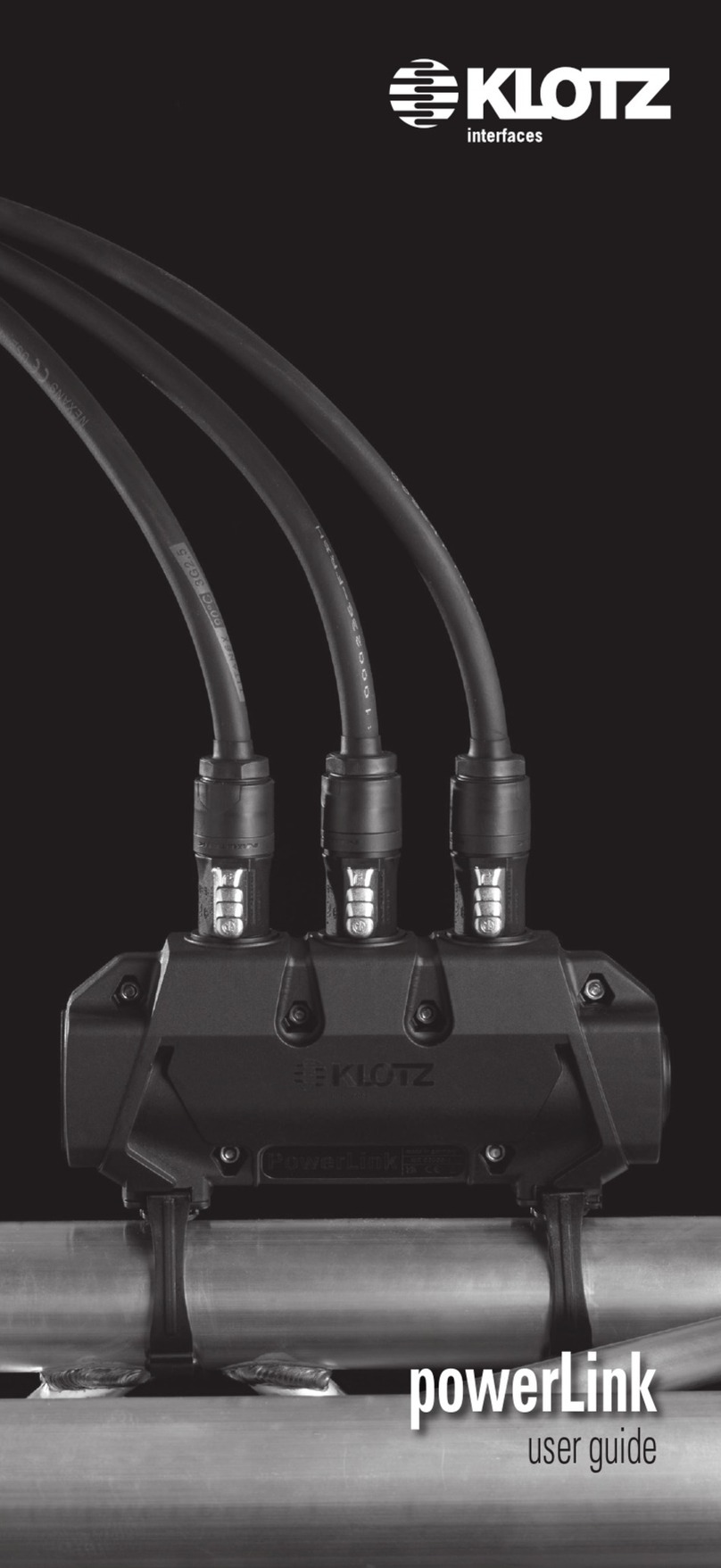
Klotz
Klotz powerLink user guide

EuroLite
EuroLite SBM-16 user manual
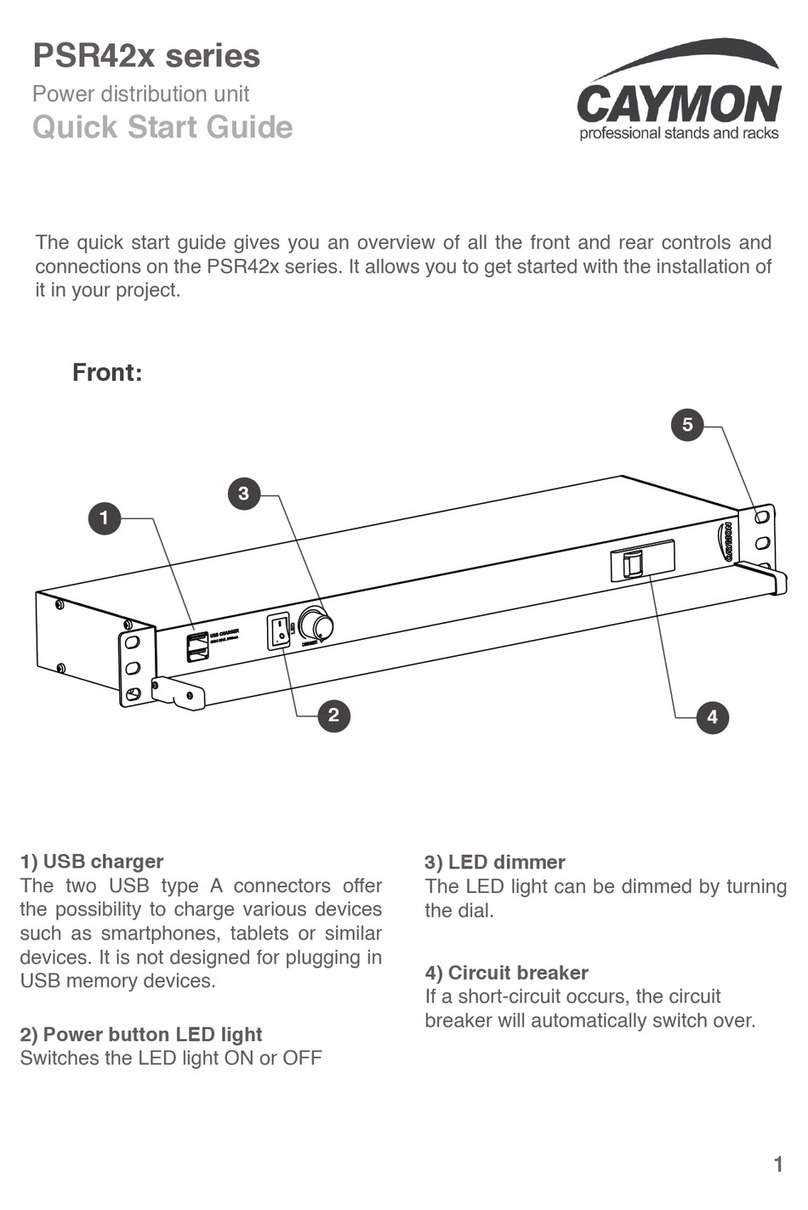
CAYMON
CAYMON PSR42 Series quick start guide
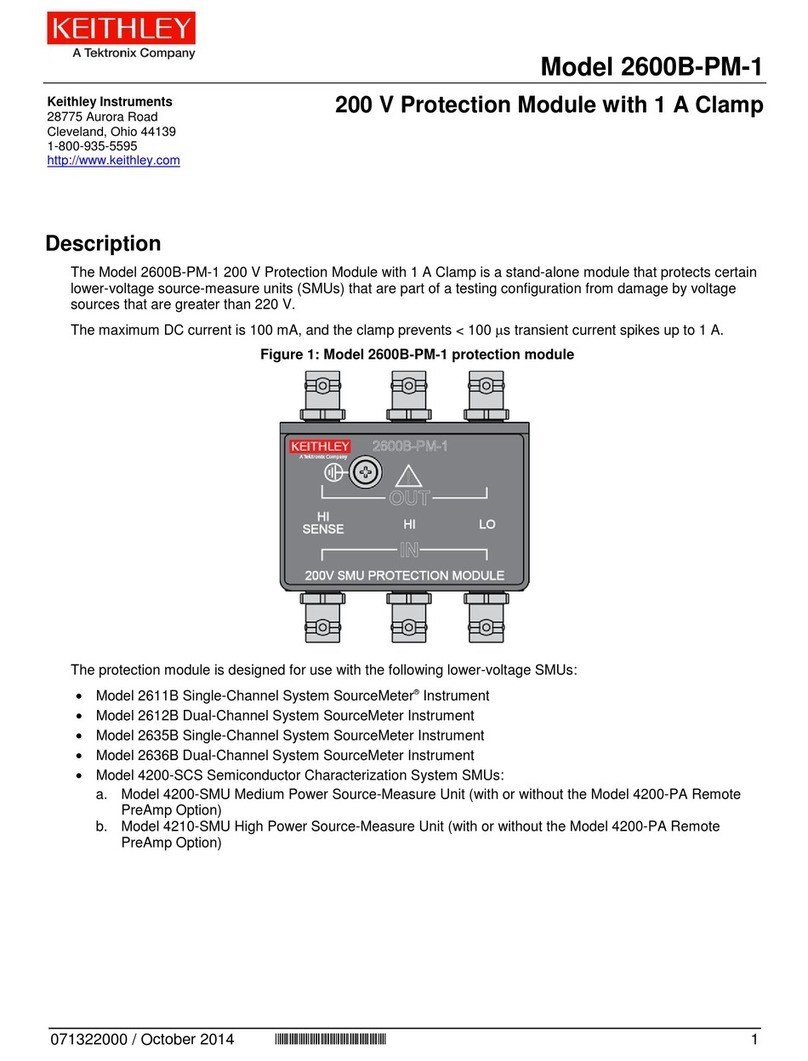
Tektronix
Tektronix Keithley 2600B-PM-1 manual
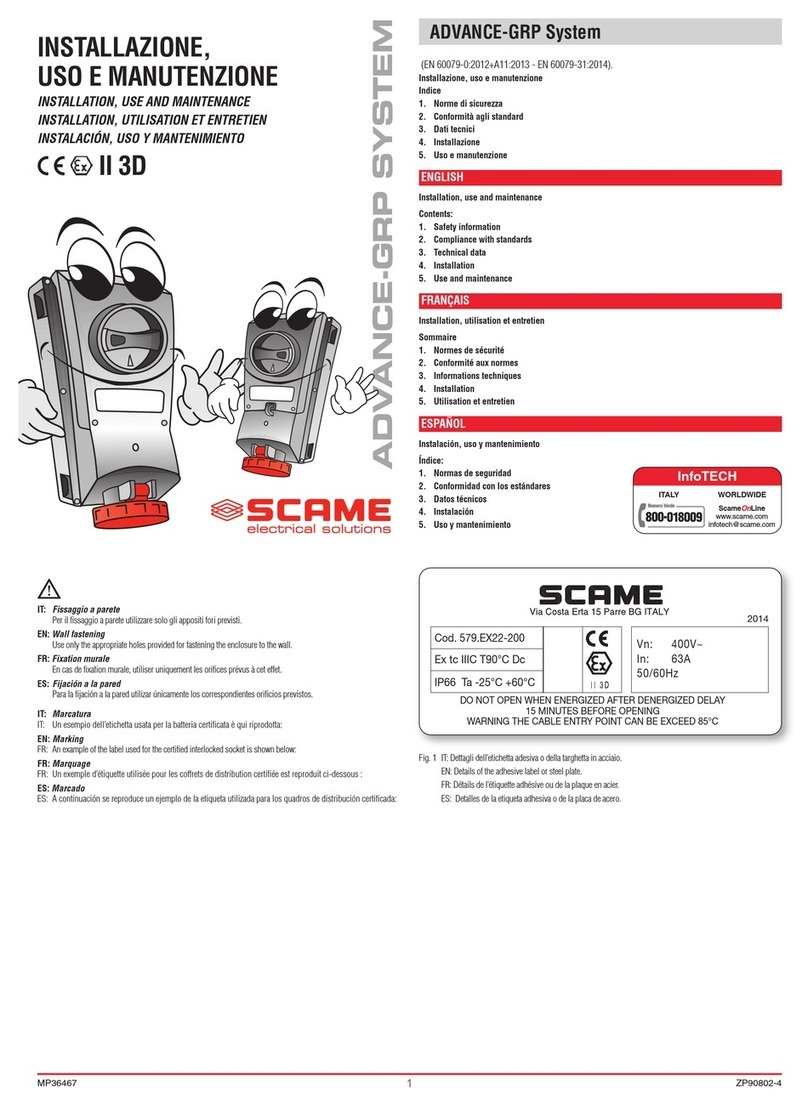
Scame electrical solutions
Scame electrical solutions ADVANCE-GRP Series Installation, use and maintenance
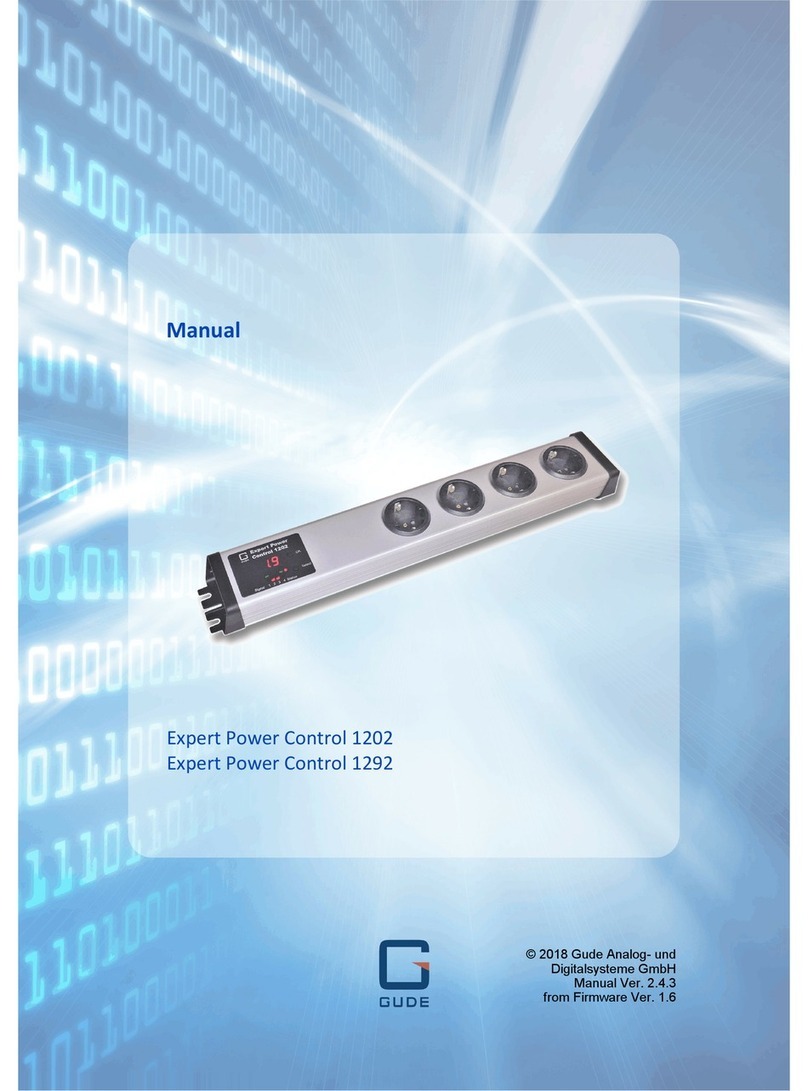
Gude
Gude Expert Power Control 1292 manual
